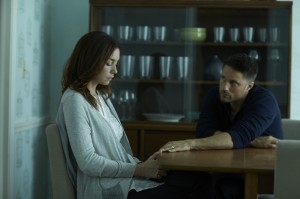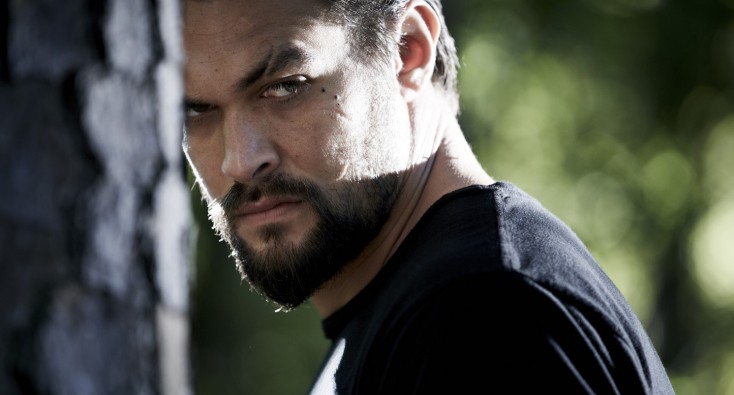 By ANGELA DAWSON
By ANGELA DAWSON
Front Row Features
HOLLYWOOD—Jason Momoa and Martin Henderson play men on opposites side of the law on the new Sundance Channel series “The Red Road,” premiering Feb. 27 at 9 p.m.
Having filmed six hour-long episodes together just outside of Atlanta (standing in for New York/New Jersey’s northern border), Momoa and Henderson spoke at the Television Critics Association Winter Press Tour about their new series.
“The Red Road” revolves around a local sheriff named Harold Jensen (played by Henderson, 39), who is struggling to keep his family together while simultaneously policing two clashing communities: the small town where he grew up and the neighboring mountains that are home to a federally unrecognized Native American tribe.
Momoa, 34, plays Phillip Kopus, the son of a white local drug lord (Tom Sizemore) and a Native American woman. Phillip is an ex-con who upon release wants to be part of a community but doesn’t quite fit into either one. When a terrible tragedy strikes, a cover up further divides these two diverse groups, and an uneasy alliance is forged between the tribe and the sheriff, leading to terrible consequences.
Q: Jason, you were born in Hawaii, and your father’s Hawaiian, but you’re also part Native American, right?
Momoa: My grandmother had Indian blood, and through her and my mom, she passed it to me. She was Pawnee. But my mom also is Irish and German.
Henderson: (teasing) Is that where the drinking comes from?
Momoa: It’s from the Hawaiian side too. When I went to Belfast, they didn’t know I was half Irish. I was like, “You guys are in trouble.”
Q: Is that why your tattoo says “Live Intoxicated” in French?
Momoa: (showing off his tattoo) Yeah! A little Charles Baudelaire (19th century French poet and translator of Edgar Allen Poe).
Q: Why did you get that tattoo?
Momoa: Because he’s one of my favorite poets. Most people wouldn’t know that. It just means so much to me: Always be drunk or live drunk. It really just means “Carpe diem. Be intoxicated with life, with poetry, with wine, with virtue.” But it’s also a beautiful poem: Live intoxicated.
Q: I wouldn’t mess with you when you were drunk.
Momoa: I don’t get ever drunk. I just get happy.
Henderson; That’s the only time to mess with him because it’s the only time you have a chance. He’s always going to be bigger and he’s always going to be stronger. But (when he’s drunk) you might be a little bit faster. (He laughs.)
Q: There’s not a lot black and white about who’s good and bad on this show.
Momoa: Absolutely. We’re throwing a wrench in the classic good guy-bad guy. That’s what was appealing to me. There are many things that are appealing about a good guy—a cop having to do bad things to protect his family. What would you do to protect your family, to what extent? That’s always been interesting to me. And, obviously, if you do those things, you have to account for them. If you’re going to make a deal with the devil, you’ve got to play with the devil. For me, it was interesting that the bad guy kind of does some good stuff. Also, he has to reconnect with this tribe. When you watch the first two episodes, no one likes him. He’s not accepted as a tribe member. They look at him funny and he’s just an outcast. He’s been raised by a white father who’s a drug dealer. So he’s not the shiny golden boy for his tribe. They don’t really accept him. So he’s got to find his roots again.
Henderson: We’re very quick, as a society, to judge, and I think what’s lovely, particularly about television as a medium, is the fact that you can tell a story over a long period of time. The writers have an opportunity to explore characters in such a way that you start to—you might not approve of what they do—but at the very least you can understand what they do, whether that’s the cycle of poverty or whatever. As a society, we’re very quick to judge the bad people and what they did wrong. I’m not saying that doing wrong is OK but we should be responsible enough to understand that if there’s a cycle of poverty, then crime comes with that.
Q: Jason, was it hard for you to get this part?
Momoa: Yeah. It was really hard for me to get this part. But it fit perfectly. When I was reading it, I was thinking, “This is perfect for me.” I hadn’t before been able to prove myself in that (contemporary crime drama) capacity. I was like, “I can do it!” I knew I could do it. Aaron (Guzikowski, the show’s creator) and (showrunner) Bridget (Carpenter) believed in me, which is fantastic. I’m excited for people to see it.
Q: How did you relate to this character or the plight of this group being the outcasts? Hawaii is a state and yet the native population tries to maintain it’s own culture and identity. So could you relate to it on that level?
Momoa: Yeah, there were plenty of things I could relate to in being a native. It wasn’t so much relating to it as much as this is the opposite—the yin to my yang—of who I am. I was raised by a mother who loved me. I didn’t have a brother. Though I was born in Hawaii, I grew up in (Norwalk, Iowa) a community that was virtually all white. My mother (on the show) doesn’t love me in this. She loved me at an early age, but I was raised by my white father, who’s a bad guy. (In my life) I’ve never had that so it was fun to dive into the polar opposite of what my life is: Wanting to be loved, wanting to be needed in the community. It’s what everyone wants. In the root of everything, Kopus (my character) wants that. He wants to be good. He wants to have a hug from his mom. It’s in him, but he’s also been raised bad. He knows he can go to the bad side very quickly. That was fun because he’s not like me. I have all the things that are good. It was fun to play the complete opposite of who I am.
Henderson: You’re a true outsider.
Q: What can you say about the direction the show is going?
Momoa: They’re going to let him back in. He doesn’t know that (at first) but that’s what’s beautiful—you watch him reach back into his roots. He’s wounded and wants to come home. He wants someone to rub his tummy. (He laughs.) Throw him a bone.
Q: What’s the setting for this show?
Henderson: About 40 miles north of Manhattan, just north of the New York state line. It’s inspired by a real community of Native Americans that are living in that area. It’s an area called the Ramapo Mountains. They’re the Ramapough Indians.
Momoa: The tribe is trying to get federal recognition. They deserve the recognition. There are a lot of white people keeping it away from them.
Henderson: There’s a lot of tension with them and the neighboring white, middle class community. Television drama needs tension and conflict.
Q: There aren’t too many TV shows involving contemporary Native Americans. There is likely to be both praise and complaints about this show’s depiction of them. Are you ready for that? Have you gotten any feedback from the Native American community yet?
Momoa: No. I haven’t gotten any. No one’s seen it yet. You want to do the best that you can but as an actor. You have a responsibility to do it right.
Henderson: The tribe on the show is fictional. It’s an important distinction. We’re not representing a particular community.





